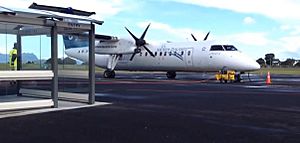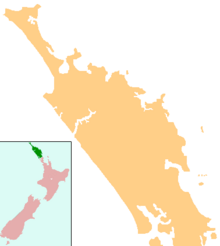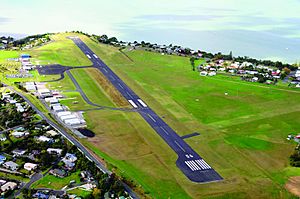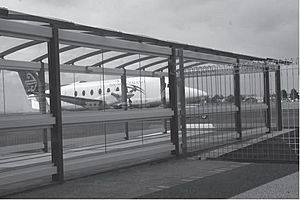Whangarei Airport facts for kids
Quick facts for kids
Whangārei Airport
|
|||||||||||||||
|---|---|---|---|---|---|---|---|---|---|---|---|---|---|---|---|

Whangārei Airport, on the Onerahi peninsula, surrounded by Whangārei Harbour
|
|||||||||||||||
| Summary | |||||||||||||||
| Airport type | Public | ||||||||||||||
| Operator | Whangārei District Airport | ||||||||||||||
| Location | Whangārei | ||||||||||||||
| Elevation AMSL | 133 ft / 40.5 m | ||||||||||||||
| Coordinates | 35°46′06″S 174°21′54″E / 35.76833°S 174.36500°E | ||||||||||||||
| Website | www.whangareiairport.co.nz | ||||||||||||||
| Map | |||||||||||||||
| Runway | |||||||||||||||
|
|||||||||||||||
| Statistics (2009) | |||||||||||||||
|
|||||||||||||||
Whangārei Airport (IATA: WRE, ICAO: NZWR) is an airport located about 4 nautical miles (7.4 km) southeast of Whangārei city. It is in the suburb of Onerahi, on the east coast of Northland in New Zealand's North Island. The airport has one main building for passengers, with two gates for planes.
Contents
Airport History: How it Started
The very first airport in Whangārei was on Pohe Island. This was in the upper part of Whangārei Harbour. In 1928, a famous pilot named Sir Charles Kingsford Smith landed his plane, the Southern Cross, there. However, this first airstrip was not very good because it was built on wet, reclaimed land.
Moving to a Better Location
People soon realized a better spot was needed for the airport. After looking at other places, the current airport site at Onerahi opened in May 1939.
World War II and the Airport
Right after the airport opened, World War II began. The RNZAF (Royal New Zealand Air Force) took over the airport. It became a training base called RNZAF Station Onerahi. Pilots practiced bombing nearby islands like Matakohe Island. The airport first had three grass runways. After the war, it was changed for public use and had two runways. Some old air force buildings are still there today, used as homes.
Early Commercial Flights
In 1948, National Airways Corporation (NAC) started flying passengers between Whangārei and Auckland twice a day. They used 10-seat Lockheed Electra planes. In 1950, they switched to smaller 6-seat de Havilland Dominie planes. This was because the airport was too small for their newer, larger planes. The smaller planes meant more flights, with six return trips daily to Auckland.
Upgrades and Bigger Planes
In December 1963, the main runway was improved and paved. It was made longer, to 1097 meters. This allowed NAC to use much larger DC3 planes. A new airport building and a control tower were also built. The DC3s could carry more people, so flights to Auckland were reduced to twice a day. Some flights continued north to other airports in Northland.
New Airlines and Changes
In 1970, NAC started using Fokker Friendship planes. Other smaller airlines also began offering flights to Auckland. One of these was Executive Air Taxis, which started in 1970. This service became popular and offered more flights.
In 1988, Air New Zealand (which took over from NAC) stopped using Friendship planes for Whangārei. Instead, their smaller airline, Eagle Airways, started flying up to five times a day using Bandeirante planes. The airport's control tower closed in 1988 because the airport was considered too small to need it.
In 1991, a new airline called Ansett New Zealand started flying to Whangārei, competing with Air New Zealand. Both airlines used Bandeirantes, and Ansett also used Dash 8s. The airport building was improved because of this growth. Ansett New Zealand stopped its service in 1998. Eagle Airways then increased its flights to meet the demand.
Modern Aircraft and Routes
In 2001, Eagle Airways started using new Beechcraft 1900D aircraft. These planes allowed them to offer new services. In 2002, direct flights began between Whangārei and Wellington. This was Eagle Airways' longest regular flight.
Other airlines also started services. Sunair began daily flights to Tauranga, Rotorua, and Napier in 2007, but stopped in 2009. Sunair returned in 2015 with flights to Whitianga and Claris. They currently fly to Great Barrier and Tauranga.
In 2008, Salt Air started an "xpress" service to Auckland. This service was later sold and then stopped.
Recent Changes to Flights
In 2009, the runway was upgraded again. This allowed larger planes like the Bombardier Q300 and some ATR 72 aircraft to use the airport. In 2011, an ATR 72 landed at Whangārei for the first time.
From April 2015, Air New Zealand stopped all Beech 1900D flights and the direct service to Wellington. Flights to and from Auckland are now handled by larger Q300 aircraft. The Q300 is currently the only type of plane Air New Zealand uses for Whangārei flights.
Airport Growth and Future Plans
Around 2009, the number of passengers and flights at Whangārei Airport grew steadily. It reached a peak of about 140,000 passengers each year. However, this growth slowed down due to global economic changes.
Runway and Terminal Upgrades
In April 2009, a $1.5 million project finished. It added a 30-meter takeoff extension and resealed the runway. This upgrade allowed larger aircraft to land. Air New Zealand began trial flights with its Bombardier Q300 aircraft. By 2015, the Q300 became the only aircraft used for the Auckland route.
On June 30, 2015, a $1.02 million upgrade to the airport was announced. The aircraft taxiway was made bigger for larger planes. Improvements were also made to paths outside the terminal and the taxi stand. A second airport entrance was built, and the car park was expanded. Inside the terminal, there was more seating, better toilets, and a bigger baggage claim area. This work finished by mid-September 2016. These upgrades helped keep the airport modern for about 15 years.
Looking for a New Airport Site
The Whangārei District Council is looking into moving the airport. The current site is too small to expand much for even larger planes. A runway of 1200m to 1350m is needed for planes expected in the next 10 to 15 years.
A site south of Whangārei was considered but was too far from the city. Another idea in 2014 was to use the old Port Whangārei site, but this is unlikely due to costs and operations.
On December 5, 2020, the Whangārei District Council bought land northwest of Whangārei. This land is a possible future site for a new airport. This purchase was made to "future-proof" the council's plans for moving the airport when needed. In March 2021, the council was looking at three possible sites and asking for $150 million in government money for the move.
On August 22, 2022, the council announced that Ruatangata was their preferred site for the new airport. This is the same area where they bought land in 2020. As of 2025, no further progress has been made on moving the airport. It is now up to other groups to plan and find money for the move.
Airlines and Destinations

Whangārei Airport has flights to several destinations:
| Airlines | Destinations |
|---|---|
| Air New Zealand | Auckland |
| Sunair | Claris, Hamilton, Kaitaia, Tauranga |
Airport Services
The airport has a modern terminal building. It has air conditioning, free Wi-Fi, and a cafe called Skyline Cafe. The terminal also has a glass tunnel that protects passengers from the weather when they walk to gates 1 and 2. There is secure parking and three rental car companies: Avis, Budget, and Hertz.
The Whangārei District Airport no longer has an Aero Club. However, flight training for small micro-light aircraft is still available through the Whangārei Flying Club. Helicopter companies like Skywork and Twin Coast Helicopters also operate from the airport. There is one aircraft maintenance facility, Northland Aeromaintenance Ltd, which fixes planes across Northland. The airport also handles private jets and larger group charter flights.
BP provides fuel for planes at the airport. Since 2006, pilots can get weather information from an AWIB (Aerodrome Weather Information Broadcast) system on radio frequency 119.8.
Incidents and Accidents
- 1955: A Tiger Moth plane crashed into Whangārei Harbour. Two people were hurt.
- 1957: Another plane, a Waco, crashed into Whangārei Harbour after its engine failed after takeoff.
- 1965: A Victa Airtourer plane went off the runway while trying to land in the rain. It bounced off a house roof and broke a greenhouse. The pilot was not hurt.
- 2005: A PAC Fletcher plane crashed 5 km west of Whangārei. Both the pilot and a passenger died.
- 2007: A Robinson R22 helicopter crashed into Whangārei Harbour during training. Both people on board were not hurt.
- 2010: A Cessna 172 plane crashed onto Church Street near runway 24. This happened because of an engine problem during landing. The pilot was not hurt, but the plane was badly damaged.
Images for kids
-
Whangarei Airport, overlooking Matakohe Island
-
Whangarei Airport apron, with Quantum Aviation occupying the old control tower building, 2008. Visible to the right is also the old airport fire station. The Onerahi Volunteer Fire Station is visible in the background. The apron has since been resealed, with new markings and the terminal has been extended.
See also
- Eagle Airways
- List of airports in New Zealand
- Onerahi
- Transport in New Zealand








